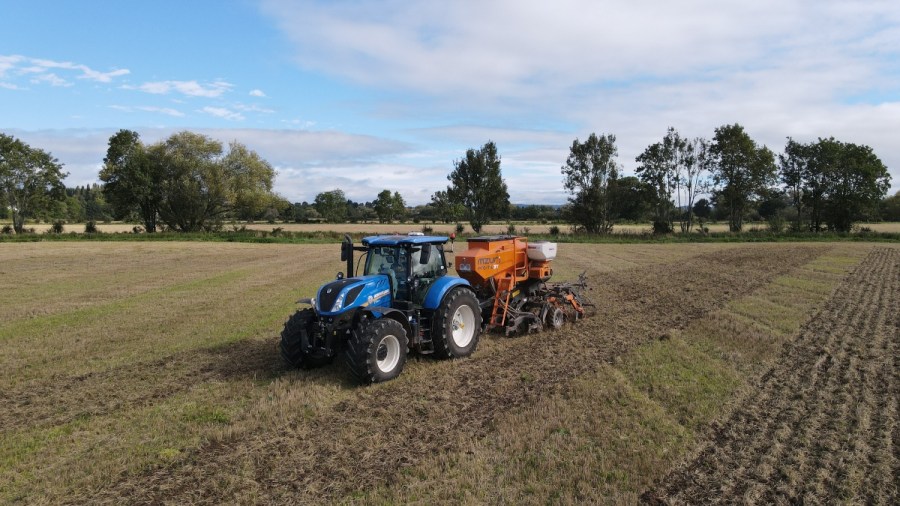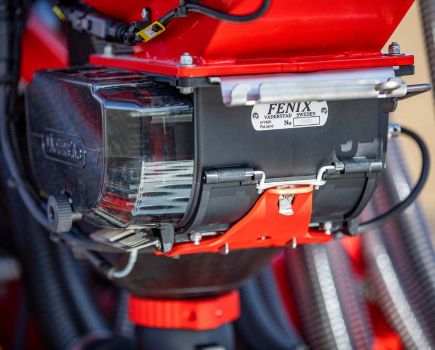Investing in a new bit of kit can bring a wide range of benefits, though not all can be quantified financially. CPM finds out how a new drill is driving broad spectrum efficiency at one Herefordshire farm.
Creating a business that’s future-proof is very important to me.
By Charlotte Cunningham
With new-born twins taking the Weir End brood up to a total of three, plus 200ha of arable crops, and a growing glamping business – as well as the prospect of a singing career on the back of his infamous ‘Combine Karaoke’ skits – quiet days are few and far between for Ally Hunter Blair.
It’s a bluebird day in Herefordshire and turning up the lane to the farmhouse a stunning crop of PT303 oilseed stands out boldly against the Wye Valley skyline, as Ally begins to talk through some of the changes he’s made since taking on the farm 10 years ago. “We’ve been at Weir End Farm since 1968 when my father, Graham, first took on the tenancy, before it became part of the Duchy of Cornwall’s Estate in 2001. Over the 40 years leading up to my succession, the farm had been run as a successful potato enterprise and I was lucky to inherit a prosperous business.”
That said, years of continuous potato rotations had left an impact on the soil, so when Ally took over in 2012, he decided to take the business in a new direction. With a view to producing crops as sustainably as possible, 2019 marked the start of a move to reduced tillage. “We’d been operating a ‘plough and plant’ system through the whole lifetime of the farm, but I decided I wanted to move to a more min-till system and so went out and bought a Simba X-Press cultivator.
“We then purchased a second-hand tine drill which worked well but wouldn’t go direct and this is something I really wanted to do. At the same time, our long-time tractor driver, Graham, was retiring and we weren’t wanting to employ anyone else.
“That said, I also didn’t want to spend more time in a tractor cab,” he laughs. “Which is ultimately why we started looking down the new drill route.”
With a hard focus on ensuring the investment was right for the farm, in 2018 Ally had six different drills out on demo, including zero-till and strip tillage types, from a variety of manufacturers. “We tried a lot, but ultimately it was the Mzuri Pro-Til 3T strip tillage drill which provided us with the most consistency in terms of establishment.”
The end goal is to be able to move to a no-till system, he explains. “However, we just haven’t got the structure for that yet. Our soil is incredibly sandy and slumps like hell. It’s got zero organic matter and though this is something we’re working on at the moment, it just needs something through it now. For us, the strip tillage drill is almost like a beginner’s step on that journey.”
The purchase coincided with successful receipt of a grant through LEADER funding – previously available through the Rural Development Programme. This subsidised 40% of the purchase cost, something that Ally says was a fundamental part of the investment. “Realistically, we wouldn’t have been able to buy any of the drills we demoed without this – £75,000 on a drill for 200ha just wouldn’t have stacked up without it.”
Looking at the Pro-Til drill, how does it work? Marketed as a one-pass drill, the Mzuri Pro-Til range offers flexibility by enabling both strip tillage and direct drilling into stubble and cover crops, explains the firm’s Will Davies, who Ally worked with to get the drill on farm.
“The leading leg cultivates the soil but leaves the crop residue on the surface between the tilled strips to help retain moisture and soil organic matter,” explains Will.
“The design itself is split into three zones – A, B and C. Starting in zone A, cultivation, the leading serrated disc cuts through the surface straw allowing residue to flow freely to either side of the tilled strip. The auto-reset tine, coupled with replacement point and wing, then cultivates the seeding zone to ensure a clean strip of moist, friable soil, free from surface residue.
Zone B then focuses on reconsolidation, with the staggered wheels reconsolidating the tilled strip to remove air pocket and ensure speedy establishment and root development, he adds.
“Finally is zone C, the business end where the seeding happens. The design ensures the coulter toolbar works independently to the coulter zone to ensure consistent and constant seed depth control.”
Ally points this out as a feature he really loves, saying it follows the contours of the land ‘beautifully’, regardless of terrain.
Band placement of fertiliser below the seed is also possible, helping to reduce fertiliser requirement – something that’s particularly beneficial given this season’s challenges with fertiliser, adds Ally.
The drill at Weir End Farm has a hopper capacity of 3400 litres, though the Pro-Til range spans up to 4300 litres on the 6T model, notes Will. Row spacing is set at 33.3cm, with nine coulters and a transport width of 2.95m.
The back up from its manufacturer has then been the cherry on the cake, continues Ally. “It sounds like I’m just saying it, but Mzuri are genuinely brilliant. I had a pin go on a Sunday afternoon once and Will was down here within an hour knocking a new one in. Problems happen and things go wrong but having people on the end of the phone, who are always there to help you get it sorted quickly, is invaluable.”
If he could change anything, Ally says it’d be the weight of the drill and the power required to pull it. “We originally ran it on a 165hp tractor, and while it did okay it struggled slightly on steeper terrain. Ultimately, we ended up buying a new tractor to tug it – a New Holland T7.270 – and now it runs brilliantly. A little gripe I also have is that it has more grease nipples than you know what to do with, so I get Mzuri out to do regular services to ensure I haven’t missed any,” he laughs.
There are also a range of optional extras, and because of the grant funding, Ally explains he ‘threw the kitchen sink’ at the purchase, meaning the Weir End drill is kitted out with all additional specifications. This includes the Stocks TJ8 slug pelleter which he says has proven to be really useful.
“We do get more slugs than we used to, especially in the rape because we’re not moving the soil around a lot. A lot of people say this is where a stubble rake comes in handy, and we demoed a Mzuri stubble rake a couple of years ago and it did a good job. But at the moment, it’s just not something we can justify.
“We’ve also got the wide leg option which would allow us to move the row spacing from 33cm to 66cm. We haven’t done this yet, but we’re currently exploring the concept of growing maize for AD, so having this will give us the flexibility to do so.”
As far as benefits go, time has been the big saver, as well as reduced establishment costs – without lower yields.
“With less passes to have to consider, I can go out drill whatever I need to and then that’s me done. The time saving alone for someone with a young family, and wants to be doing everything, is just a no brainer,” says Ally.
Despite concerns that reducing tillage can sometimes cause a reduction in yield, this hasn’t been the case here. “We’ve had no noticeable increase either, though. However, we’re not a big 12t/ha of wheat arable farm, we’re more aiming around a modest 9t/ha mark. So this set up works well for us.”
While yields may have stayed stable, he has been able to cut his establishment costs by about 50%, now averaging around £45-50/ha under the new system.
As well as freeing up more time to spend with his young family, Ally says the efficiency brought by the drill gives him more time to work on diversification projects, such as his glamping pods – Bertha’s Box and Shepherd’s View – the former of which Ally created himself by converting an old horse lorry. “While crop production will always be our bread and butter, I think to be truly sustainable, it’s important to have different income streams. By altering our approach to the arable side of things, we’re able to put more time to other projects.”
The farm also has an area dedicated to an equestrian arena providing riding instruction, run by Ally’s wife Annie to match her passion and skills with horses with another way to diversify income, he adds.
There are also environmental benefits from reduced tillage and less passes brought by the Pro-Til drill. “We recently did a carbon audit of the farm and we’re doing much better than we thought – producing about 0.5t CO2e/ha,” he muses. “While we’re still able to farm very much in the way we want to, having Prince Charles as our landlord – who has been an advocate for farming with the environment in mind for a very long time – it’s good to be able to align our priorities with those of the Duchy.”
Anecdotally, he believes the soil is starting to show signs of improvement since running the Mzuri drill too. “I’ve noticed particularly over the past 12 months that the tractor is pulling the drill a lot easier, so I think there are definitely some improvements starting to happen below the surface.”
But not everyone is as enthusiastic about this way of establishment…
“My dad just calls it a ‘bloody mess’,” laughs Ally. “Aesthetically, he doesn’t like it, but from a business point of view, he very much backs the cost-effectiveness – and time efficiency – brought by the Mzuri.”
With eldest daughter, India, already showing a keen interest in farming – and a generation left on the tenancy – Ally says he hopes to leave the farm in a position that would allow his children to succeed him when the time comes, should they wish. “Creating a business that’s future-proof is very important to me and the Mzuri drill is a fundamental part of the system and plan.
“I was very lucky to have a farm to take on at a young age and I’d love for my children to have the same opportunity. India is obsessed with farming, and watches everything I do. I hope she stays that way as I’d love one day for her to be able to take on the farm, or for all three of them to form a farming business.
“I’m far from a regen legend,” he laughs. “I’m just trying to make my farm work the best I can for everyone.”
Staying social
When he’s not busy planting crops, or thinking up his next project, you’re likely to find Ally popping up on your Twitter or Instagram feed. Over the past few years, his social following has grown, enhanced by leading appearances in Discovery’s Born Mucky: Life on the Farm.
So why is media so valuable in this new era of farming? “Above everything else it’s something I enjoy doing, but I think social media can be really helpful to show off what farming is about and answer the questions people have – particularly when those questions are from people outside the industry or younger farmers wanting advice or to know more about something you’re doing,” believes Ally.
“Within the farming community itself, it definitely also helps to bring a sense of togetherness into what can otherwise be a really isolated world.”
Farm facts
Weir End Farm, Ross-on-Wye, Herefordshire
- Farm area: 200ha
- Soil type: Sandy loam
- Cropping: Wheat, spring barley, oilseed rape, beans and sugar beet




